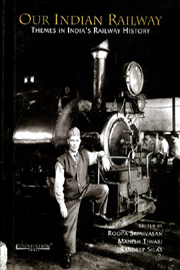Book contents
- Frontmatter
- Contents
- Foreword
- Preface
- Introduction
- 1 The Colonial Context of the Bengal Renaissance: A Note on Early Railway–Thinking in Bengal
- 2 Minute by Dalhousie on Introduction of Railways in India, as Submitted to the Court of Directors, 4 July 1850
- 3 Ackworth Committee Report
- 4 Competition and Adaptation: The Operation of Railways in Northern India: Uttar Pradesh 1860–1914
- 5 Economic Nationalism and the Railway Debate, circa 1880-1905
- 6 Railway Policing and Security in Colonial India, c. 1860–1930
- 7 Indian Nationalism and Railways
- 8 The Railway in Colonial India: Between Ideas and Impacts
- 9 The Dark Side of the Force: Mistakes, Mismanagement and the Malfeasance in Early Railways of the British Indian Empire
- 10 Tunnels and Bridges: Railways, Narrative and Power in two Novels of India
- 11 A View of the History of Indian Railways
- 12 The Romance of Steam
- Index
- Plate section
10 - Tunnels and Bridges: Railways, Narrative and Power in two Novels of India
Published online by Cambridge University Press: 26 October 2011
- Frontmatter
- Contents
- Foreword
- Preface
- Introduction
- 1 The Colonial Context of the Bengal Renaissance: A Note on Early Railway–Thinking in Bengal
- 2 Minute by Dalhousie on Introduction of Railways in India, as Submitted to the Court of Directors, 4 July 1850
- 3 Ackworth Committee Report
- 4 Competition and Adaptation: The Operation of Railways in Northern India: Uttar Pradesh 1860–1914
- 5 Economic Nationalism and the Railway Debate, circa 1880-1905
- 6 Railway Policing and Security in Colonial India, c. 1860–1930
- 7 Indian Nationalism and Railways
- 8 The Railway in Colonial India: Between Ideas and Impacts
- 9 The Dark Side of the Force: Mistakes, Mismanagement and the Malfeasance in Early Railways of the British Indian Empire
- 10 Tunnels and Bridges: Railways, Narrative and Power in two Novels of India
- 11 A View of the History of Indian Railways
- 12 The Romance of Steam
- Index
- Plate section
Summary
Writing of the need to regain imaginatively the land lost to the coloniser, Edward W. Said has commented that, ‘what radically distinguishes the imagination of anti-imperialism … is the primacy of the geographical in it’. There is, likewise, a discernible preoccupation with images of the land in postcolonial fiction and particularly with modes of movement across, through and between aspects of the physical terrain, some of which owe their origins to colonial technological innovations. (One thinks of the prevalence of the road as a channel for neo-colonialism and resistance, and of the repeated image of the river journey in African fiction). In India the struggle for narrative and power most frequently coheres around the image of the railway journey and the vast spaces it traverses and hence brings into proximity. As for postcolonial fiction, so too for the colonial variety it supersedes; Martin Green, in his book Dreams of Adventure, Deeds of Empire remarks that ‘geography became a sort of heraldry of imperialism – every mountain and river evokes the excitement of conquest and possession’: how much greater the excitement of being able to tame and harness such terrain? In colonial adventure fiction such drives are marked by the elevation of the English hero to the status of sovereign of all he surveys, and the concomitant tendency towards the depopulation of the colonial territory. What is essential for an understanding of the imperial romance novel is a recognition of the co-extensive relationship between colonising and writing.
- Type
- Chapter
- Information
- Our Indian RailwayThemes in India's Railway History, pp. 214 - 229Publisher: Foundation BooksPrint publication year: 2006

